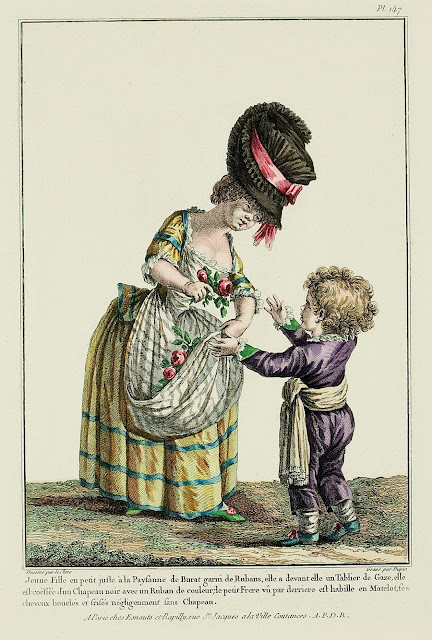Galerie des Modes, 32e Cahier, 6e Figure
Young Girl in a little jacket à la Paysanne of Buras, trimmed with Ribbons, she has in front a Gauze Apron, she is coiffed with a black Hat with a colored Ribbon; the little Brother seen from the back is dressed in a Matelot, his hair, curled and frised negligently, without a hat. (1780)





The wizened, hardened faces on these children are seriously keeping me up at night. This little lady has the charm of a Chucky doll and the gentle disposition of a Latvian hooker.
ReplyDeleteWhich is why I have nominated you for the Very Inspiring Blogger Award!
http://threadheaded.blogspot.com/2013/03/id-like-to-thank-academy.html
I'm going to have to post a photo of this one black and white fashion plate from my copy of Peterson's 1857 - at least this girl's features are even a little bit even.
DeleteThank you so much for the award! It made my day that you called me incredibly skilled.
You ARE incredibly skilled, but you're welcome. I certainly can't finish a seam the way you can. If you are "incredibly skilled" then I can scramble and maybe become "reluctantly adequate" one day. By-the-by, what is the difference between a manchette and an engageant? I've been meaning to ask.
DeleteYou are way too nice!
DeleteThere isn't one exactly. As far as I can tell, manchette was the more common term in France in the late 18th century, or at least it's the most common one in GdM. Engageante is also in the same period dictionaries, but those are the only places I've seen the word while translating (so far). I can find a 1695 reference in French, and apart from that it seems to mostly come up in English, Victorian contexts. So I've been getting out of the habit of using it (although Hallie Larkin had me geting out of the habit a while ago with her post on not using "fichu" and "engageante" in American contexts).